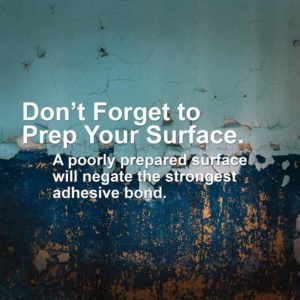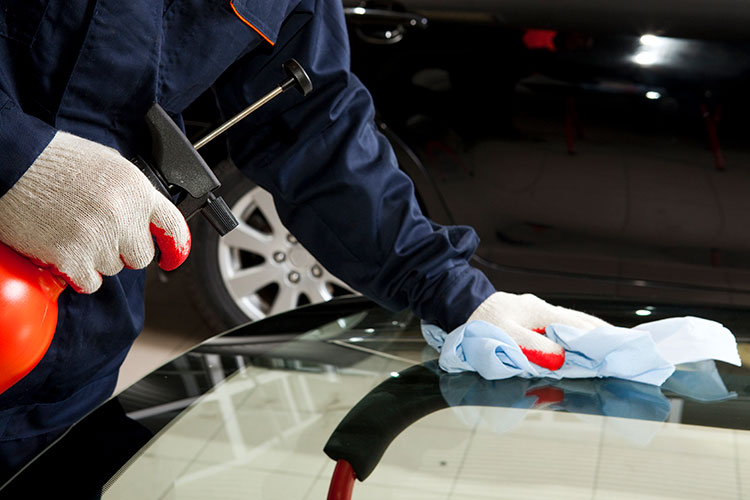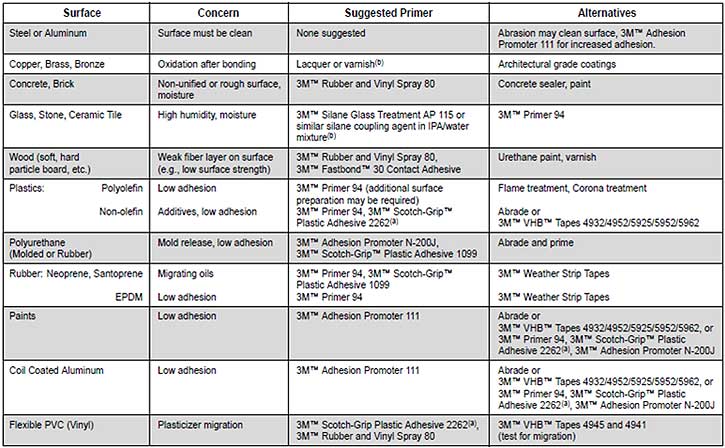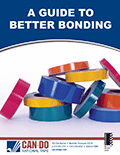Start with a Surface Scrub
In the majority of situations, a good scrub with a 50:50 mixture of isopropyl alcohol (IPA) and water will do the job. The alcohol will dissolve light grease and water will get rid of dirt and accumulated dust. Make sure the surface is thoroughly dry before applying the adhesive tape. Try not to touch the cleaned surface as finger oils and other contaminants may affect the bond.


When Additional Surface Prep is Needed
While the IPA/water mixture is sufficient in the majority of cases, there are exceptions. For these challenging applications extra surface preparation can help assure a successful bond. Additional bonding surface preparation steps may include:
Remove Heavy Oils
Using a degreaser or solvent-based cleaner may be required for some surface prep. 3M™ Prep Solvent 70, 3M™ Citrus Base Cleaner, mineral spirits, naphtha or similar solvents will cut the heavier-weight oils. Follow up with the IPA/water mixture until the oil is gone.
Abrade the Surface
Roughing up the surface (i.e. sanding) will loosen up any accumulated dirt, rust, or chipped paint and aid in the adhesion to painted surfaces or plastic items. A finely-abraded surface with shallow scratches created by a circular motion (rather than straight lines) has the best potential for a strong and persistent bond. This method can create up to a 40% increase in surface area and can result in greater immediate and long-term bonding potential.
Depending on the level of abrasion needed, the following can be used:
- Scrub pads
- Fine steel wool
- Sandpaper
- Palm sander (helpful for larger jobs)
Always clean with the IPA/water solution, or other solvents, and make sure all loose particles are removed.
Use Caution When Abrading for Surface Prep: Choose fine rather than coarse abrasive materials because too-rough a substrate may inhibit the adhesive flow onto the surface. While it is not typical, some high-bond tapes adhere best to smooth, glassy surfaces, so double check with the manufacturer before you abrade the surface and compromise the bond strength.
Prime the Surface
Priming a low surface energy substrate (e.g. a plastic or painted surface), or a surface coated with an adhesion-impeding chemical, will significantly increase the immediate bond as well as the persistence of the join over time. A primer layer can also block any elements of the substrate from migrating out over time, and eroding the bond.
Seal Porous Surfaces
Porous or fibrous materials (wood, concrete, particle board, etc.) will need to be sealed to achieve a uniform surface for maximum bond. Common sealing materials include paint, varnish or other hard surface coatings such as epoxies.

Surface Preparation for Bonding Unique Materials
Glass, Stone, and Ceramic
Siliceous materials such as glass, stone, and ceramics attract and hold water naturally. Without a sealant, exposure to moisture or high humidity will likely degrade the pressure sensitive adhesive tape bond. Silane coupling agents, added to the IPA/water cleaner can help condition the surface and reduce the hydrophilic (water-loving) properties of the surface. This will safeguard the adhesive bond in high moisture environments.
Copper, Brass, and Bronze
Copper and copper-containing alloys (brass, bronze) are prone to oxidation even under the adhesive tape. Coating the surface with a lacquer or varnish will seal the surface and prevent rust from forming under the tape. Be sure to test the tape bond to verify a strong bond.
PVC and Other Vinyl Products
Many industrial vinyl products such as PVC contain a chemical called a plasticizer that keeps the material flexible. Over time, this plasticizer can migrate into the adhesive tape and degrade the adhesion. There are products available on the market that can block the migration of the plasticizer into the tape. Rubber materials like neoprene and EPDM (ethylene propylene diene terpolymer) will require the use of a primer or other adhesion promoting material to achieve a strong, stable bond.

Choosing the right adhesives for your application makes all the difference.
Tell Us About Your Project

